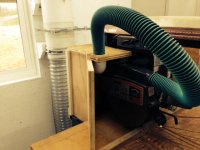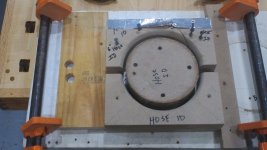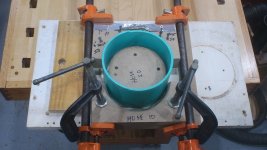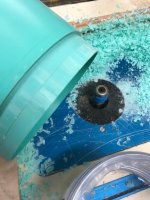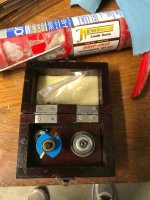Before I began my Clearvue dust collector odessey I read thru the posts, Bill Pentz's site, etc.
I knew at the end I would have to face the flex hose/pvc issue.
First, my accolades to any who managed to stretch a piece of 6" flex hose (I used Wynn's) over a piece of 6" S&D pvc - as one post mentioned, the pipe has an od of 6.25" and the hose has an id of 6" - that last quarter of an inch (with the wire reinforcement) is a bit tough.
My method is a trifle crude but works well and fast (well and fast is always good).
I clamped about a 12" length of 2 x 4 into the vise so that a "tongue" would stick out beyond the vice by about 6". This tongue enable me to slip a few inches of the flex hose over the tongue and clamp a portion of the hose near the end of the hose to the tongue. Then, positioning the hose so that I could somewhat isolate a section of the hose with its internal wire re-inforcement at the front/closest corner of the tongue (bend the hose down towards the floor so as to "raise" that section of hose & wire a bit), I could easily cut/nip thru the wire with a sawzall.
Of course, this also nipped thru the hose; however, that is not an issue. I would then remove the hose from the "jig" (elegant jig) and, using a pair of vicegrips, pull the cut wire out from the exposed end of the hose. The trick here is to cut no more than a coil or so of wire; otherwise, it requires too much force to remove the internal wire, and most woodworkers would lack the manly strength to enable doing this.

Repeat the process a few times so that two or three coils of wire have been removed. Of course, in subsequent approaches to removing the wire, oneself is sequentially grabbing the cut end of the wire via the nipped-out opening starting at the last cut coil section in the body of the hose and, in this way, working up the hose.
The mischief in trying to get the hose over the pvc is the wire reinforcement; not so much the body of the hose. Once the wire has been removed, it is a fairly simple matter to use a heat gun on the hose body, and stretch it over the pvc.
I don't recommend going more than several coils of hose up onto the pvc (firstly, it does not seem to be really necessary to go more than that amount of hose) since, as the hose cools, it is harder to pull it up onto the pvc.
Once the hose is on the pvc, I secure it with aluminum tape - other types of tape could be used. In some instances I will also clamp it; but, the clamping is hardly necessary. The taping will cover over the slits in the hose from the sawzall.
That's it - after a few trys/practice it shouldn't take more than 5 minutes or so from beginning the process to having the hose pulled up onto the pipe.
The same process works for the 4" hose & pipe although it is actually harder to pull the hose up onto the pvc since, when you heat the hose, it shrinks a bit. However, it is a non-issue.
I hope this helps



